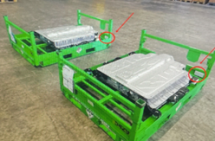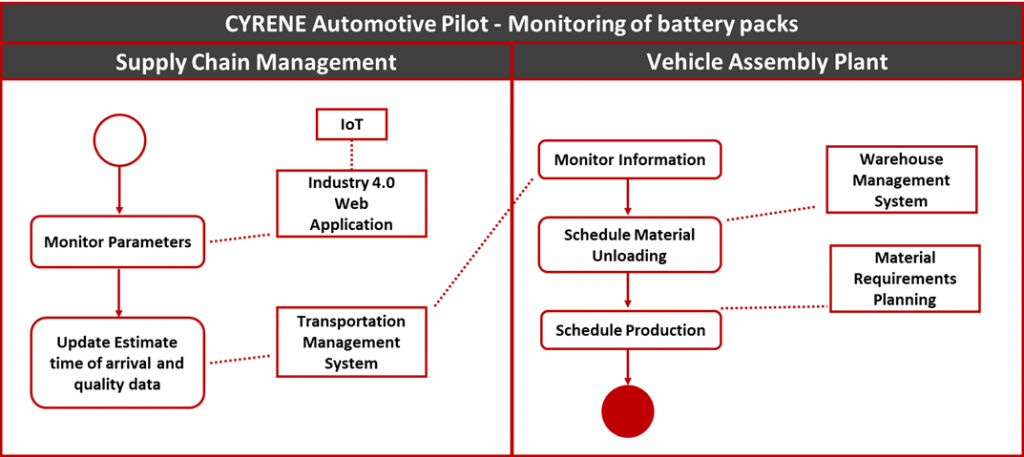As described in some earlier posts about Supply Chain Services – Automotive Pilot, and Conformity Assessment in Automotive Supply Chains, we have explored the primary supply services in the automotive chain and how they are managed from the manufacturers’ point of view, summarizing the general aspects of the Automotive Pilot, which is adopted to assess the conformity in the Automotive Supply Chain and specifically within the Automotive Inbound Logistics processes and assets. It was already pointed out the relevance of the IoT devices and the data provided by these CPS. These Data Loggers will be installed on some critical containers identified by CRF, and will be tracked and monitored in order to know the position of the containers, together with some important parameters (such as mechanical shocks, exposure to extreme temperatures or strong magnetic fields) related to the status of the transported components. In this specific case, it is important to avoid strong mechanical accelerations or temperature shocks to ensure the quality of the components that will be mounted on the passenger vehicles. Furthermore, the CYRENE platform, developed and adopted in the Automotive Pilot, will ensure the cybersecurity of data, people, and processes during the components supply, allowing the protection of ICT systems and processes.
In this post, we provide some details about the specificities of this Automotive Pilot, together with the main devices and components of its infrastructure. First, it is important to point out that relevant benefits derive, in general, from the adoption of smarter and more efficient processes in inbound logistics, such as the capability itself of identifying the inefficiencies by being able to track and monitor the critical components in the automotive production process, at any time. Specifically, this feature of tracking and tracing allows knowing where products are always, from presence to positioning. So, it becomes possible to run quicker, automated inventory counts and find misplaced products immediately. Clearly, these benefits should be higher than the costs of research, development, installation, and operation of the newly introduced systems. This is the reason why the automotive pilot for CYRENE was addressed towards the SC of some very critical and expensive components in our product, such as the battery modules of the FIAT 500e BEV (Battery Electric Vehicle).
Figure. 1. FIAT 500e – Detail of the battery module, located on the floorpan of the car.
The FIAT 500e, produced in the Mirafiori settlement Turin site, was the best-selling electric car in Italy in 2020, with 10,720 units. Which is a very significant result, considering that the production of this vehicle started in October 2020; in 2021, 53,819 were built. Regarding the SC, roughly 5500 battery carriers, stackable (see Fig. 2), are used for the transport of these delicate and expensive components, during their delivery route from the production site of the Gigafactory of Samsung SDI, in Hungary, towards the Mirafiori plant the for their installation in the vehicles.
Figure 2. IoT Data Loggers installed in the individual battery carriers (left); carriers stacked into the trucks (right).
A single battery carrier is used for every individual battery pack, and in the CYRENE pilot the tracing of the batteries is carried out at this level of granularity: one dedicated IoT positioning and data gathering device is installed in the battery carriers (to get data regarding the single batteries, not on the trucks, as a whole). This aspect is a very important and distinctive feature of the CRF automotive pilot Use Case. Let’s repeat and underline this aspect: the pilot is designed and prepared to trace and monitor the battery pack individually, not at the level of the container used to transport a given expedition. Obviously, this choice may appear as overabundant and expensive, at least up to some extent, considering that – as said – 5500 battery carriers should be equipped to cover 100% of the current production needs. Nevertheless, the installation of the IoT data gathering devices will cover initially only a fraction of the total (< 1% of the carriers), thus significantly limiting the deployment costs, but will allow validating the approach, to fully exploit the core CYRENE targets, and to comply at the same time with the business value for Stellantis:
- By putting in full operation a pilot project for the fine tracing of the Inbound Logistics and quality assurance of key components, such as the battery packs of the BEV;
- By providing a Conformity Assessment of the security and resilience of supply chain services, interconnected IT infrastructures and the individual devices (CPS, IoT, such as loggers) that support the operations of the SCs.
As summarized in the following picture, key entities/components involved in the SC management and in the Vehicle Assembly plant infrastructures are the following:
- IoT devices, based on NB-IoT communication standards, and feeding the Automotive Pilot with latitude, longitude, temperature, shock, and other relevant info on a close-to-real-time basis
- The Field Gateway, a Server located in the NB-IoT service provider’s premises, acts as the Edge Server for the Automotive Pilot
- Industry 4.0 Web Client and Parameter Monitoring app, providing graphical rendering and data inspection and aggregation analytics for the data provided by the field loggers
- Quality assessment and real-time ETA for the traced components
- Overall logistics event provision and triggering to the TMS (Transportation Management System)
- Battery status monitoring and certification app in the Vehicle Assembly Plant
- RTMS to coordinate and manage the real-time scheduling of the unloading procedures, linked to the overall logistics of the plant (through the WMS)
- Production scheduling and triggering of the material provision (Material Requirement Planning
Automotive Pilot configuration, testing, and operation are ongoing! We will report about our achievements soon! Stay tuned!
Do you have experience in cybersecurity in the field of Automotive Supply Chains? Have you ever faced cybersecurity issues in your Supply Chain?
Reach out to us and share your views either by using our contact form or by following our social media accounts on Twitter and LinkedIn.
Don’t forget to subscribe to our Newsletter for regular updates!
This blog is signed by: the CRF team
KEY FACTS
Project Coordinator: Sofoklis Efremidis
Institution: Maggioli SPA
Email: info{at}cyrene.eu
Start: 1-10-2020
Duration: 36 months
Participating organisations: 14
Number of countries: 10
FUNDING
 This project has received funding from the European Union’s Horizon 2020 Research and Innovation program under grant agreement No 952690. The website reflects only the view of the author(s) and the Commission is not responsible for any use that may be made of the information it contains.
This project has received funding from the European Union’s Horizon 2020 Research and Innovation program under grant agreement No 952690. The website reflects only the view of the author(s) and the Commission is not responsible for any use that may be made of the information it contains.







